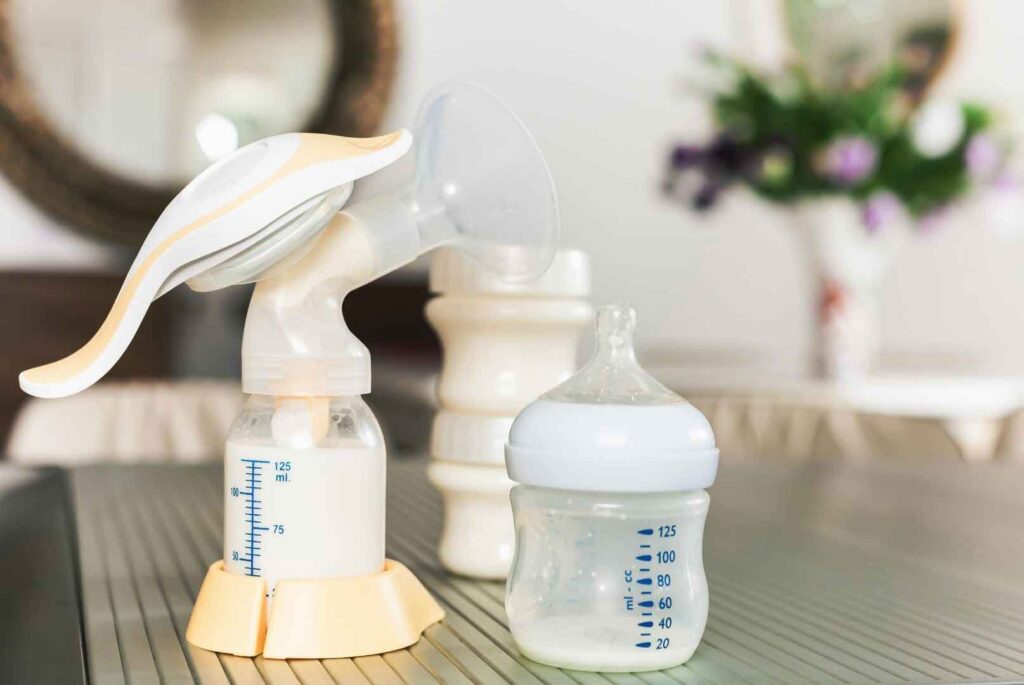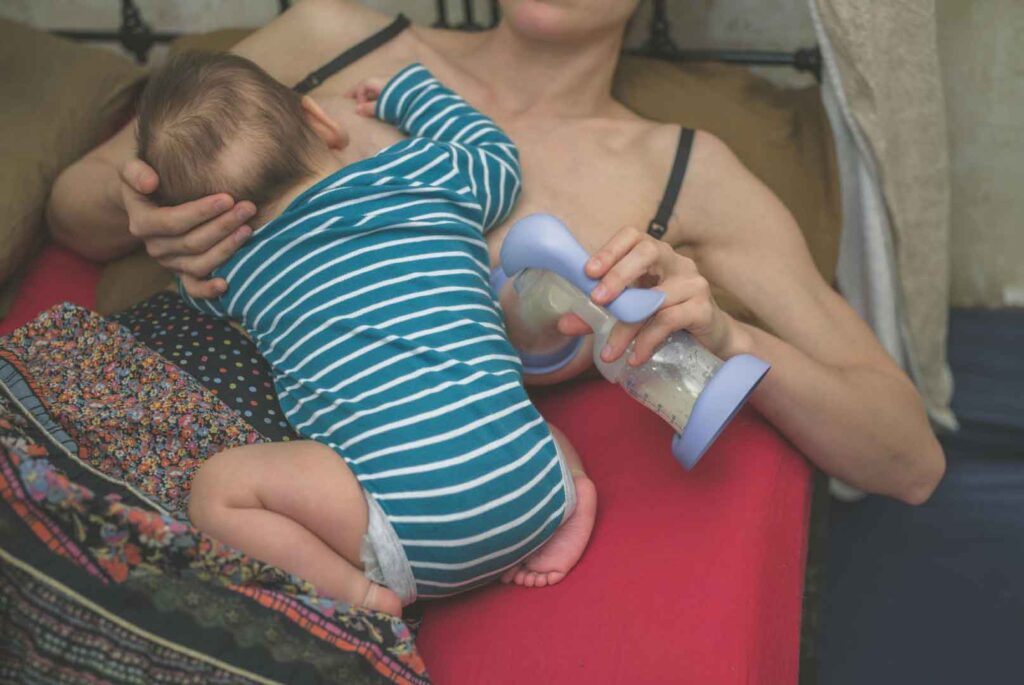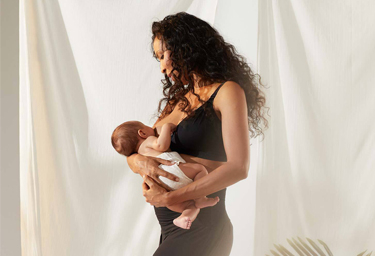Whether you’re a new mum, heading back to work, want to share the load with your partner or need to be away from your baby, pumping breast milk is an effective and efficient way to keep bub happy and fed. There are so many reasons to consider breast pumping, so here’s a few tips and tricks to kickstart your journey and get you pumping like a pro.
Why should I consider pumping?
- You might be going back to work
- Your baby may not be latching properly
- You might want to share the feeding with your partner
- You may have a premature baby and need to keep your milk supply up
- You may need to be away from you baby
- Your milk supply may not be adequate
- You may have an oversupply of milk
- You may want to donate milk
- You may have mastitis and need to drain the breast
- Your milk may have been contaminated by certain medications or alcohol
And the list goes on…

What sort of breast pump to use?
This depends on…
- How much you want to spend
- How often you will use the breast pump
- Where you want to use the breast pump
- Whether you want an electric or manual breast pump
If you are only going to pump every now and again, then I suggest getting a simple hand pump. It’s best to start off with one of these anyway to help you control the way you’re pumping.
Some women freeze up when first put onto a mechanical pump as they feel a bit like a dairy cow. To get the most out of your pumping session you need to feel as relaxed as possible.
If you’re planning to exclusively feed bub from a bottle, it’s worth investing in a mechanical pump. This will reduce the amount of time you spend on each pumping session as they’re more efficient.
If you’re not 100% sure pumping is for you, try renting a pump to begin with. Most hospitals and good pharmacies offer a rental service.
When not to pump:
- When you are overtired.
- When you have just fed from both sides
- If you don’t have clean equipment (if you’re planning to use your milk, not pump and dump)
- When you’re dehydrated or haven’t had enough water during the day — when you’re breastfeeding you should be aiming for 3L a day, as opposed to the usual 2L. It’s a lot, so go and have a glass now.
So, lets get started…

Learn to hand express:
1. Start off in a warm shower or apply a warm compress (warm washer) to your breast. If you are nursing your baby on your other breast, the milk may flow easier.
2. Massage your breast with one hand (if you are holding your baby with the other) or two.
3. Massage from the outside inwards with steady pressure directly towards your nipple.
4. Squeeze and press your fingers towards your chest. They should be on, or on the outside of your areola.
TIPS:
- It’s not like milking a cow
- You don’t’ want to pinch your nipple – keep your fingers a firm distance apart and pushgently towards your chest
- Relax and think about your baby
- Exhale and release your shoulders
- Lean forward if you are having difficulty

Learn to pump:
Remember the tips from hand expressing. When you first start off using the pump, try from the opposite breast that you’re feeding from. Bub will already have the milk flowing. Then when you are ready to change breasts, your baby should be able to feed some more from the breast you’ve just pumped from.
Or if you don’t want to pump while breastfeeding, start off pumping just before you feed. This way, you will have a more ample milk supply.
1. Relax (I know, easier said than done when you’re pumping for the first time)
2. Position the cups — this part is all trial and error. Try positioning your breast inside the cups so that your nipple is at the center. Don’t push too much flesh inside the cups, the pump will do this for you. Make sure you have a good seal around the edges. If you need to reposition the cups, break the seal first with a finger and then gently remove the cup and try again.
3. If you’re using a mechanical pump, start off with a slow setting and only do it for a short amount of time. 10 minutes on your first day is perfect.
4. Don’t pump for longer, even if you’re able to! If you are having success and can pump a full 150ml, your body will then make a lot more. This can quickly lead to engorgement and other problems. So, it’s best to do the pumping routine with slow and gentle increments.
5. If using a hand pump, slow and steady pumping is okay and once again, only for 10 minutes. In 3 days time, increase to 15 minutes. After 7 days, increase to a full pump. Then after 10 days, progress to pumping both breasts if you need to.
6. The way that you start pumping should also be the way that you finish pumping. If you are pumping continually every day and then you suddenly stop, the milk flow can change dramatically and once again, you may end up with engorgements. So if you decide to cease pumping for any reason, wean yourself off.
Note: When you’re pumping your breasts may increase in size, it’s best to make sure you are fully supported and wearing a comfortable bra to ensure that you’re not damaging your ligaments with the extra weight of your breasts. Damaged ligaments are the main cause of sagging.
How much should I pump?
It’s not a matter of quantity, but rather time. You might get super excited that you are able to and start filling up satchel after satchel, but this is a sure fire way to encourage an oversupply, which could lead to problems when you’re trying to reduce your flow down the line.
Try to pump only when you would normally be feeding your baby. If your aim isn’t to increase your supply, try pumping at even intervals, similar to if you were breastfeeding bub.
Feed from one side and pump from the other. Then after your baby has finished, you may be able to pump some more from the breast they’ve just fed from, and vice versa.
A general rule of thumb is not to overdo it.
Storing breast milk:
Remember that the longer you store your breast milk, the less likely it is to be suitable for your baby.
Your body produces the perfect concoction of milk for your baby whether he is sick, thirsty, hot or hungry — so keep this in mind.
If you are pumping in summer and feeding this milk to your baby in winter, the milk will taste very different to that from your breast at the same time.
How long can I keep breast milk?
- Fresh milk — 4 hours at room temperature
- Refrigerated milk — 48 hours
- Frozen milk — 9 months
- Thawed milk — 24 hours in the fridge
How often do I pump if I’m exclusively pumping?
- Newborn — every 3 hours
- After 6 weeks — every 4 hours
- After 6 months — every 4 hours during the day but not in the evenings or overnight
Overall tip and advice:
Make sure you are getting enough sleep and rest, plenty of water and good nutrition. When you are breastfeeding you will burn on average an extra 500 calories a day, and the same rules apply to pumping, so make sure you are ready for the journey. Happy pumping, mamas!
—
Disclaimer: Cake does not provide medical advice, diagnosis, or treatment. Any information published on this website or by this brand is not intended as a substitute for medical advice, and you should not take any action before consulting with a healthcare professional.
LIKE WHAT YOU READ?
Join CakeMama Club & get 10% OFF your first order!
Plus you’ll get tips + tricks for pregnancy, postpartum & breastfeeding, get member-only offers, earn CakeCoins every time you shop + more. Learn more














































































































































